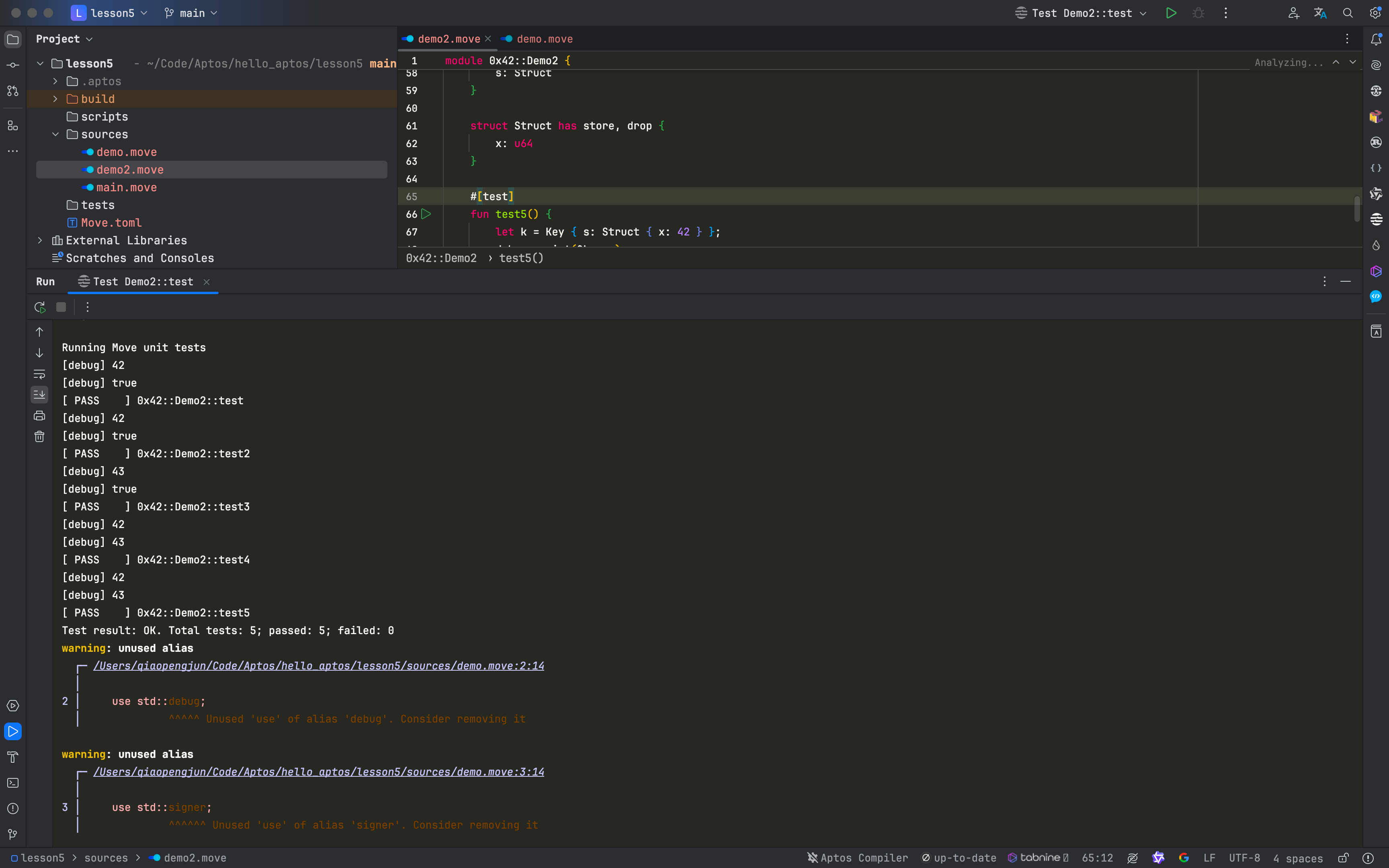Aptos
深入解读 Aptos Move 的 Struct 特性与四大能力
- 寻月隐君
- 发布于 2024-09-12 16:33
- 阅读 2251
深入解读AptosMove的Struct特性与四大能力在AptosMove编程语言中,struct是一种用于存储和组织数据的核心结构。它不仅可以嵌套使用,还能赋予特定的能力,从而增强其在不同场景中的使用效率。在本文中,我们将详细讲解AptosMove中的struct特性
深入解读 Aptos Move 的 Struct 特性与四大能力
在 Aptos Move 编程语言中,struct 是一种用于存储和组织数据的核心结构。它不仅可以嵌套使用,还能赋予特定的能力,从而增强其在不同场景中的使用效率。在本文中,我们将详细讲解 Aptos Move 中的 struct 特性,以及它们如何利用四种关键能力:copy、drop、store 和 key 来实现更强的功能。
本文对 Aptos Move 编程语言中的 struct 结构体及其特性进行了深入解读,重点介绍了 struct 的四大能力:copy(复制)、drop(销毁)、store(全局存储)和 key(全局存储键)。我们通过代码示例详细演示了这些能力如何影响 struct 的行为,特别是在全局存储、资源管理和复制操作中的应用。文章还提供了使用这些能力进行数据操作的实际用例,帮助开发者更好地理解并在项目中灵活运用 Aptos Move 的强大特性。
APTOS-MOVE STRUCT 特性解读
核心概念
Aptos Move 的 Struct 结构体用于存储结构化数据。Struct 可以相互嵌套,并可以作为资源存储在特定地址下。”
- 命名必须以大写字母开头
- 可以通过 has 关键字赋予能力
struct Person {
ape: u8,
birthday: u32,
}
struct People {
people: vector<Person>,
}修饰符与四大能力
Copy - 值能够被复制
Drop - 值可以在作用域结束时被自动清理
Key - 值可以用作于全局存储的键 Key
Store - 值可以存储在全局存储中
除 Struct 类型外,其他的类型默认具备 store、drop、copy 的能力,Struct 最终是存储在用户的地址上(或者被销毁),不存在 Aptos 合约里,Aptos 合约是一个全纯的函数。
The Four Abilities
The four abilities are:
copy- Allows values of types with this ability to be copied.
drop- Allows values of types with this ability to be popped/dropped.
store- Allows values of types with this ability to exist inside a struct in global storage.
key- Allows the type to serve as a key for global storage operations.
1. Drop
值能够在使用结束后被销毁
//drop
struct Coin {
b: bool
}
#[test]
fun test6() {
let c = Coin { b: true }; // 报错,没有 drop 修饰符
}
//drop
struct Coin has drop {
b: bool,
}
#[test]
fun test6() {
let c = Coin { b: true }; // 正常运行,拥有 drop 能力
}2. copy
值能够在使用结束后被复制
//copy
struct CanCopy has drop {
b: bool,
}
#[test]
fun test5() {
let c = CanCopy { b: true };
let c1 = c; // no copy
let CanCopy { b } = &mut c1;
*b = false;
debug::print(&c1.b);
}修改之后
// copy
struct CanCopy has copy, drop {
b: bool,
}
#[test]
fun test5() {
let c = CanCopy { b: true };
let c1 = c; // copy
let CanCopy { b } = &mut c1;
*b = false;
debug::print(&c1.b);
debug::print(&c.b);
}3. Key
值可以用作于全局存储的键 Key
//key
struct Coin has key {
value: u64,
}
public entry fun mint(account: &signer, value: u64) {
move_to(account, Coin { value });
}
#[test(account = @0x42)]
public fun test_mint(account: &signer) acquires Coin {
let addr = signer::address_of(account);
mint(account, 100);
let coin = borrow_global<Coin>(addr).value;
debug::print(&coin);
}4. store
值可以被全局存储,通常配合Key使用
//store
struct Key has key, drop {
a: Store,
}
struct Store has drop {
b: bool,
}
#[test]
fun test6() {
let k = Key {
a: Store { b: true },
};
debug::print(&k.a.b); // 会报错
}父 的有 Key 子的必须有 Store
//store
struct Key has key, drop {
a: Store,
}
struct Store has store, drop {
b: bool,
}
#[test]
fun test6() {
let k = Key {
a: Store { b: true },
};
debug::print(&k.a.b);
}实操
module 0x42::Demo2 {
use std::debug;
use std::signer;
// drop
struct Foo has drop {
u: u64,
b: bool
}
#[test]
fun test() {
let f = Foo { u: 42, b: true };
// let Foo { u, b } = f;
// debug::print(&u);
// debug::print(&b);
debug::print(&f.u);
debug::print(&f.b);
}
#[test]
fun test2() {
let f = Foo { u: 42, b: true };
let Foo { u, b } = f;
debug::print(&u);
debug::print(&b);
}
#[test]
fun test3() {
let f = Foo { u: 42, b: true };
let Foo { u, b } = &mut f;
*u = 43;
debug::print(&f.u);
debug::print(&f.b);
}
// copy
struct CanCopy has copy, drop {
u: u64,
b: bool
}
#[test]
fun test4() {
let b1 = CanCopy { u: 42, b: true };
let b2 = copy b1;
let CanCopy { u, b } = &mut b2;
*u = 43;
debug::print(&b1.u);
debug::print(&b2.u);
}
// store
struct Key has key, drop {
s: Struct
}
struct Struct has store, drop {
x: u64
}
#[test]
fun test5() {
let k = Key { s: Struct { x: 42 } };
debug::print(&k.s.x);
let Struct { x } = &mut k.s;
*x = 43;
debug::print(&k.s.x);
}
}
运行测试

Aptos Move 中的 struct 是一个强大的工具,结合四大能力,可以极大地增强数据管理的灵活性与安全性。理解并灵活运用这些能力,是编写高效、安全智能合约的基础。在未来的开发中,这些能力将为资源管理和全局存储提供更多可能性。
